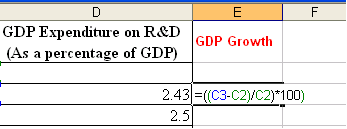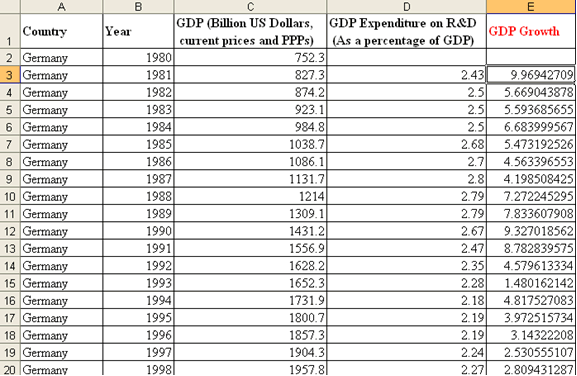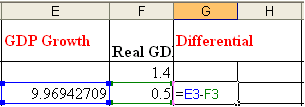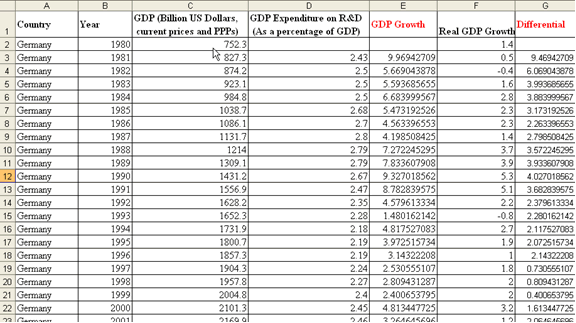In this activity we will look at how to derive a variable. A derived variable is one that has been created out of the original values in the dataset. Researchers are often looking for a particular derived variable in a databank. Even if the derived variable does not exist as a series title in the dataset, it might be easily constructed using Excel or a statistical package. Always try to think about whether the series you are searching for is available in an alternative form. For instance, if you are looking for GDP annual percentage growth and only GDP is available, you can simply calculate its values. This is also true for percentages. Many researchers are looking for indicators expressed as a proportion of a country's GDP. Even if this is not given, a simple calculation - dividing the value by the GDP - can potentially allow for greater comparability across countries and save you the time you would have spent trying to find the data elsewhere.
In this case, we will to derive the growth of a variable from the values in individual years. The change in GDP between successive years, or GDP growth, is an indicator that is widely used to assess how well an economy is being managed. The growth in GDP between year1 and year2 is expressed as a percentage:

Open workingdataset.xls file and select the OECD Factbook data download worksheet. Go to the first available column (column E) and type in GDP Growth as the variable heading. Leaving the top cell blank, and click in the next cell down and type in the formula =((C3 - C2)/C2)*100. This will take the value in cell C3 (German GDP in 1981) subtract the value in cell C2 (German GDP in 1980) and express the difference as a growth rate using the formula above. Note that the top cell is left blank for this new variable as we are looking at the growth between two successive years.

Press enter to generate the value. Use the fill handle technique you used in the first activity to fill the rest of the German GDP growth column. Your answers should be the same as the values in column I in the Derived and chart data worksheet:

OECD Factbook data download worksheet
Repeat this process to generate the GDP growth values for Japan, the UK and US.
Growth in GDP does not result in an increase in purchasing power if the growth is simply due to a rise in inflation. So, rather than this nominal, or unadjusted, rate of growth of GDP, in practice economists use growth rates that are free of direct effects of inflation, or real GDP growth. Real GDP growth reveals the change of economic output after adjusting for inflation by dividing the nominal GDP by a price deflator. The OECD Factbook provides data on real GDP growth and this can be found in the Derived and chart data worksheet. The next variable we are going to derive is the differential between real and nominal GDP growth.
The price differential of GDP is the difference between the real and nominal GDP growth rates so the formula to generate this variable is simply:
Nominal GDP - Real GDP
So we can generate a Differential column by inputting a formula in the same way we generated the growth rates. Go to the OECD Factbook data download worksheet and and type in Differential as the variable heading in column G. Enter the formula =E3-F3 into cell G3. This takes the GDP Growth value and subtracts the Real GDP Growth value to give the differential.

Again, use the fill handle to extend the formula to all years for the series:

OECD Factbook data download worksheet
Note the real GDP growth values have a missing value for one of the years, 2002. This creates a null value in the differential for this year.